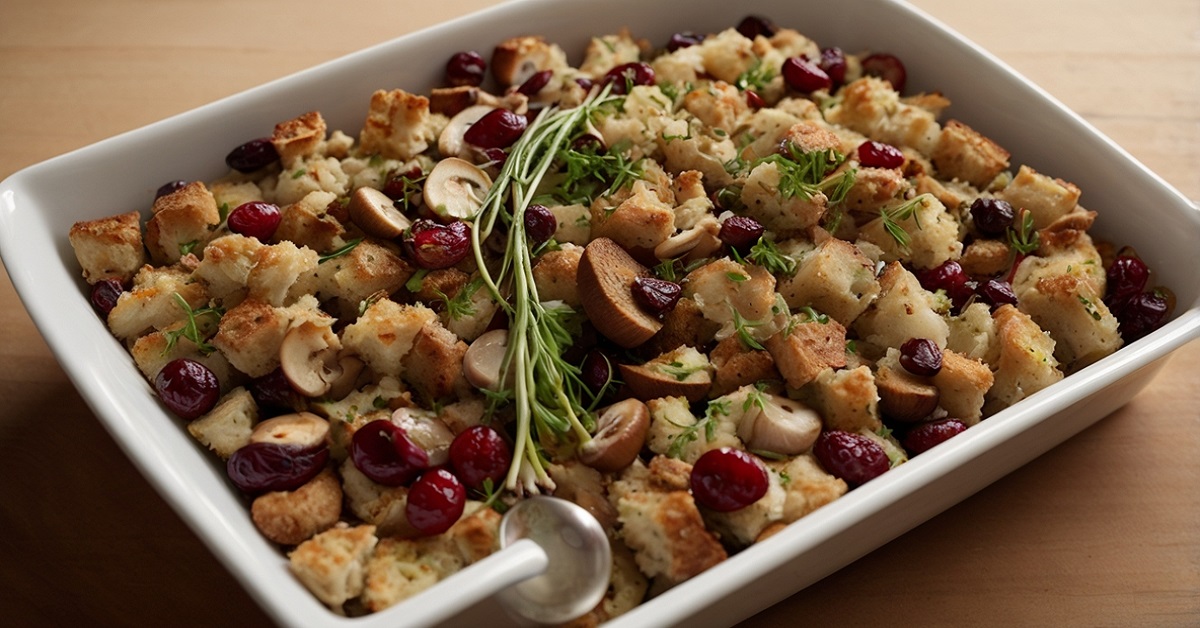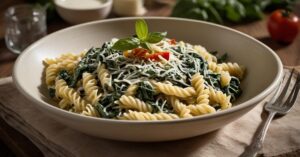Vegetarian Bread Stuffing Recipe. You ever find yourself staring down a pan of stuffing and thinking, this again? Soggy cubes. Beige. Sad. Like it gave up before it even hit the oven. Now picture this instead roasty, golden corners.
A gutsy hit of fresh herbs. Toasted sourdough that still puts up a fight under your fork. Deep umami, but no meat in sight. This isn’t some limp side dish hiding behind the turkey. This is a stuffing with backbone. And it just so happens to be 100% vegetarian.
This vegetarian bread stuffing doesn’t play sidekick. It demands a plate of its own.
It’s not a salad. It’s not some fussy casserole with 13 “hidden” superfoods. It’s just honest, old-school bread stuffing reimagined. Earthy, savory, and rich with layers of flavor from roasted aromatics, toasted nuts, and a stock so good you’ll want to sip it like soup.
This one’s for the pros who want to serve stuffing that people don’t push to the edge of the plate. Let’s break it down.
Ingredients & Substitutions

You’re building flavour from the ground up here. No boxed mix, no shortcuts. Everything matters.
- Rustic bread (450g – about 1 lb): Sourdough, country loaf, or a crusty baguette. Needs to be 1–2 days old. If you’re in a rush, cube and toast it in a 150°C (300°F) oven for 20–25 mins until bone dry.
- Substitute: Any sturdy, non-sweet loaf. Brioche is a nope too rich.
- Olive oil or unsalted butter (90–120ml): Butter gives it body. Oil keeps it clean and vegan.
- Yellow onions (2 medium, finely diced): Don’t skimp. These are base notes.
- Celery (3 ribs, diced small): For that classic crunch-n-snap contrast.
- Leeks (1 large, white + light green parts only): Milder than onion, adds depth.
- Garlic (5 cloves, minced): Cook it gently or it’ll bite.
- Crimini mushrooms (200g): Adds deep umami. Slice thick so they don’t vanish.
- Substitute: Porcini or shiitake. Dried porcini, soaked and chopped, add extra oomph.
- Fresh thyme (1 tbsp, chopped): More delicate than dried. Use just 1 tsp if dried.
- Fresh sage (2 tsp, finely chopped): Big autumn energy. Don’t overdo it it dominates.
- Parsley (a fistful, chopped rough): Save this for the end.
- Vegetable stock (600–700ml): Homemade is king. Store-bought? Go low-sodium.
- Toasted walnuts or pecans (optional, ½ cup): Texture! Toast ‘em till fragrant.
- Eggs (2, beaten): Optional, but helps bind if you want a sliceable, casserole-style finish.
- Omit for vegan. Add a flax egg if you need that bind.
- Salt & black pepper: Season every layer.
Pro note: If your herbs are floppy and tired, don’t bother. Skip or sub with good dried ones. Fresh herbs should still snap when you bend the stem.
Step-by-Step Instructions
Step 1: Dry out the bread.
Cube the bread into rough 1″ chunks. No perfect cubes. Jagged bits make better texture. If it’s already dry, great. If not, bake in a low oven until crisp not golden, just dried.
Step 2: Sauté the aromatics.
In a big skillet or wide-bottomed pan, melt the butter or heat the oil over medium. Toss in onions, celery, and leeks. Season with a pinch of salt. Cook till everything’s translucent and starting to catch a little golden around the edges. About 10–15 minutes. Stir now and then.
Add garlic. Lower the heat a bit so it doesn’t scorch. Let it mellow for 2 mins.
Step 3: Add mushrooms + herbs.
Turn up the heat slightly. Mushrooms go in. Let them sit a few seconds before stirring this helps ‘em brown instead of just steaming. After 5–7 mins, when they’re golden and reduced, stir in thyme, sage, and a crack of black pepper.
Smell that? That’s the base of everything.
Step 4: Combine bread + mix-ins.
Toss the dried bread cubes into a huge bowl. Pour over the hot veg mix. Stir it up gently so you don’t pulverize the bread. Add chopped parsley and toasted nuts if using.
Step 5: Add stock gradually.
Pour stock in slowly, a ladle at a time. Toss gently after each addition. You’re aiming for moist, not soggy. The bread should feel soft with a little give, but not collapse into mush.
Add eggs now if using. Fold in evenly.
Step 6: Rest + bake.
Let it sit 10 mins so the bread fully absorbs all that flavour. Taste. Adjust salt.
Transfer to a buttered or oiled baking dish. Press down gently don’t compress too much. Bake at 180°C (350°F) for 35–45 mins uncovered, until golden and crusty on top, edges bubbling.
Want extra crisp? Broil the top for 2 mins at the end.
Cooking Techniques & Science
Why stale bread?
Stale or dried bread acts like a sponge. Fresh bread turns to paste. You want the structure to hold under liquid think of it like making panatela, not porridge.
Why sauté each veg separately?
Because they cook at different speeds. Mushrooms release water. Onions caramelize. If you dump it all in together, you get steam. No flavour. Build it in layers, like painting.
Why rest before baking?
Bread needs time to soak up the stock evenly. Otherwise you get dry corners and wet pockets. That’s stuffing sabotage.
Do I need eggs?
Nope. It’s there for structure. If you want the stuffing to spoon out in fluffy clumps, skip it. For a firm, sliceable result say, for plating or stuffing squash use ‘em.
Why fresh herbs?
Dried herbs have concentrated oils. They’re potent but one-note. Fresh herbs give brightness and layers. Add dried early, fresh near the end.
Serving & Pairing Suggestions

Scoop it hot with a big spoon, rustic-style. Or slice it in squares if you added eggs and packed it tight.
Top with crispy shallots, or a dollop of tangy cranberry compote. Want drama? Drizzle brown butter over the top before serving.
Pair with:
- Roasted root veg with maple and mustard.
- A bitter greens salad think chicory, Friese, or radicchio.
- A mushroom or miso gravy to amplify the umami.
- Dry cider or an earthy Pinot Noir.
Want to take it full main-dish? Stuff it into a roasted acorn squash or inside a pastry crust like a Wellington.
FAQs About Vegetarian Bread Stuffing Recipe
1. Can I make this stuffing ahead of time?
Yes, up to 2 days in advance. Assemble and refrigerate unbaked, tightly covered. Bake just before serving. Add a splash of stock if it looks dry.
2. How do I make this vegan?
Use olive oil instead of butter. Skip the eggs. Add more stock and press the stuffing down a bit to help it bind.
3. Can I stuff this into a turkey or other roast?
Don’t stuff it into a bird it won’t cook evenly and it’ll get soggy. But you can stuff it into squash or Portobello’s for a beautiful veggie main.
4. What’s the best bread to use?
Go for chewy, crusty bread like sourdough or rustic white. Avoid sandwich bread or anything too soft and sweet.
5. Can I freeze the stuffing?
Yes. Cool completely, portion, and freeze. Reheat covered with foil at 160°C (325°F) until warmed through, then uncover to crisp the top.
Want a slightly spicier vibe? Add a pinch of chili flakes to the sauté. Or mix in some roasted poblano for smoky depth.
Stuffing shouldn’t be a throwaway. This one won’t be.
Final Thoughts
This isn’t just a meatless version of something else. It stands on its own. No meat. No regrets.
It’s layered. Textural. A little sweet from the onions, nutty from the bread and walnuts, with deep, roasty flavour from mushrooms and herbs. The top crunches. The inside’s tender. Every bite’s got purpose.
Best part? It holds beautifully. Reheat in the oven at 160°C (325°F), uncovered, with a splash of stock to revive it. Still bangin’ on day three.




